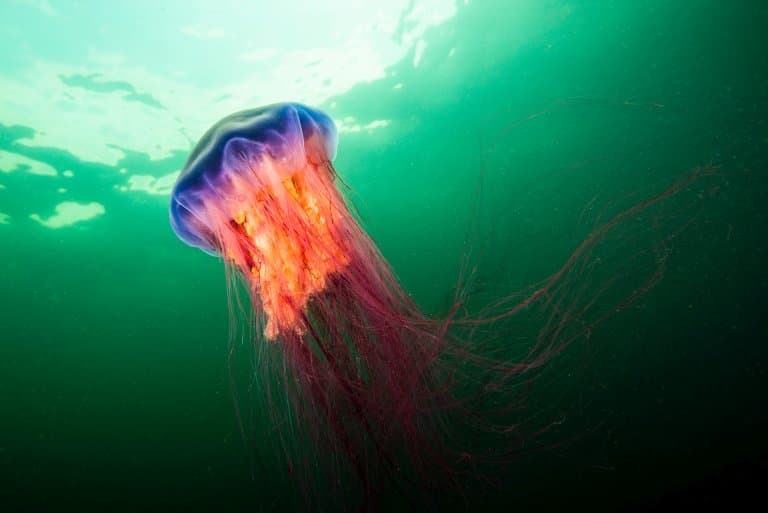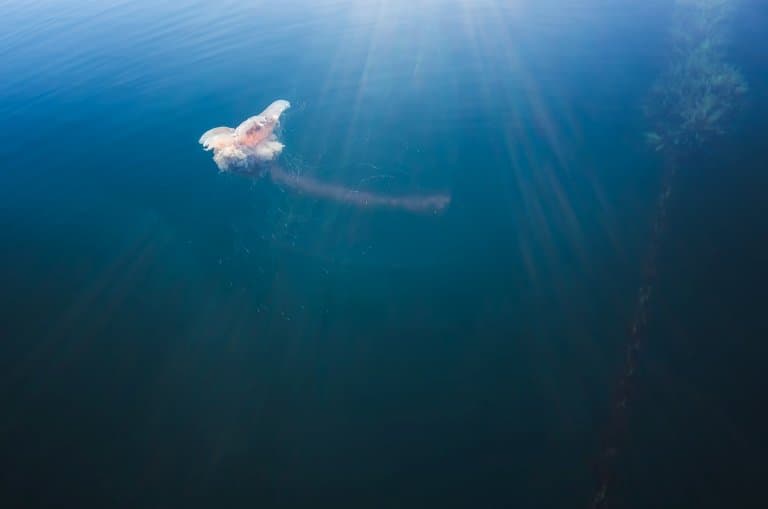Lion’s Mane Jellyfish Profile
One of the longest creatures in the ocean doesn’t even have a brain. It’s a colossal tentacled monster that drags with it a thick coat of venomous limbs that give the animal its name.
The lion’s mane jellyfish inhabits cold waters in the Arctic, Atlantic and Pacific oceans and is also known as the giant jellyfish, or arctic red jellyfish.

Lion’s Mane Jellyfish Facts Overview
| Habitat: | Cold waters |
| Location: | Arctic, Atlantic, Pacific |
| Lifespan: | Approx. 1 year |
| Size: | 36.6 meters (120 ft) long, 210 cm (7ft) across |
| Weight: | Around 200 kg |
| Color: | Orange, brown, red |
| Diet: | Zooplankton, small fish |
| Predators: | Birds, large fish, turtles |
| Top Speed: | Slow |
| No. of Species: |
1 |
| Conservation Status: |
Not listed |
They spend most of their time near the waters surface, drifting in the oceans currents, with little control. Because of this, they are solitary, and rarely seen traveling in groups.
Lion’s mane jellies are far from the most dangerous animal in the sea, though they’re long enough to entangle numerous prey items and beachgoers, and their sting, while usually harmless, can be medically significant.
They have no brain and no place to go, other than where the water takes them, and they go from egg to monstrosity in the space of a single year.
Interesting Lion’s Mane Jellyfish Facts
1. Their name is inspired by their tentacles
The jellyfish’s long, thin hair-like trailing tentacles are reminiscent of a lions mane.
They use their sticky stinging tentacles to trap, and pull in their prey which includes zooplankton, small fish, crustaceans and other smaller jellyfish.
2. They are longer than a blue whale
Everyone knows the biggest animal in the ocean, but not as many know that it isn’t the longest.
The Lion’s mane jellyfish is on average around 1.5 feet (40 cm) in length, but can reach lengths of 36.6 meters (120ft), making it over three meters longer than the longest-recorded blue whale!
And even this isn’t the longest animal. The Bootlace worm is thought to reach 55m long, over twice the average length of a blue whale.
3. They don’t have a brain
This isn’t quite an insult, but it might be a little misleading. While jellyfish look like there’s nothing inside them, they do have a nervous system.
Like most radially-symmetrical animals, they have a star-shaped nervous system, made up of clusters of nerves called ganglia, responsible for the minimal amount of movement a jellyfish is capable of.
Despite this simplicity, they’ve been around for hundreds of millions of years. They are able to smell, detect light, and figure out which way is up. 1
4. It can produce its own light, and glow in the dark
The lion’s mane jellyfish has bioluminescent properties, which means it can generate its own light and glow at night.
This glow can be used to lure prey close enough to them to grab them with their tentacles!

5. They eat, and discard waste from their mouth
Inside their bell-shaped body, they have a single opening for their mouth. Like all jellies, they use this opening to both eat, and discard their waste! Yuck.
They can also use their mouths to squirt water, which helps propel them forward.
6. Enormous plankton
The definition of zooplankton technically refers to how much control an animal has over where it lives. A tuna can decide it doesn’t like this spot of the sea and deliberately navigate to a better one. Most jellyfish can’t do that.
Brainless bags of 90%-95% water that barely move of their own accord are, almost entirely, at the mercy of the currents. And despite being hundreds of kilos and tens of meters long, this definition of zooplankton means that you can be bigger than a sardine and still be considered plankton.
While lion mane jellies can pump their bell to some degree, they’re still pretty much helpless in the water other than maintaining depth. They tend to stay within 20 meters of the surface and go wherever the tide takes them, even if that’s well up onto the beach to die.

7. 8 Lobes of pain
While they’re alive, they have an impressive array of dangly bits. Their great bell is made up of eight lobes of tentacles and eight lobes of sensory rhopalia which house their receptor cells for light, balance, and smell.
The tentacled lobes are home to its hair-like appendages that give the animal its name, and there can be up to 800 of these. Inside each cluster is a series of oral arms, which the animal uses to move its paralysed prey up to its mouth.
8. Warm and bubbly
These exceptionally long tentacles drift out away from the bell and may stretch out to over 30 meters. Being so long and so everywhere, it’s very easy for divers to encounter the stings.
In fact, these jellies sometimes form great clusters, several kilometres across, called shoals. That’s a lot of tentacle!
Thankfully, the sting is rarely dangerous to humans. It’s been described as similar to swimming through warmer water and giving a bubble, effervescent sensation.
It’s not always safe, and some people can have allergic reactions or cramps, so it’s certainly to be avoided, but in almost every case of a sting in the water, there are no fatalities.
It’s thought that a single lion’s mane jellyfish stung 150 people in a single session in 2010. People reported tingling, itching and burning. 2
9. They are part of a growing problem
Jellyfish periodic blooms are common all over the world. However, there’s a growing interest in these phenomena as a symptom of climate change and overfishing.
It’s still early days, but it does appear that jellyfish blooms may be exacerbating a problem caused by the fishing industry, allowing species like the lion’s mane to enter and remain in ecological niches that were previously limited by predators.
The vast number of new jellies in an area can wipe up the tiny plankton that forms the basis of the food web, and this can add to the problem that overfishing is having on ecosystems.
An increase in jellyfish like this is known as the jellification of the ocean and is not as delicious as it might sound. In Japan, the overuse of fertilisers on crops has led indirectly to Lion’s Mane jellyfish blooms.
Increases in water temperature also seem to correlate with increases in the formation of the larvae, rapidly multiplying these animals, and with a reduction in local fauna from fishing, there’s very little to eat them. 3

10. From polyp to jelly
Adult Lion’s mane jellies reproduce both asexually and sexually, having two distinct sexes. The females carry their eggs in their oral tentacles, keeping them after fertilisation until they reach the larval stage.
At this point, they’ll be dropped or placed on a substrate where they’ll affix themselves to it and live out their polyp stage. Like anemones, they’ll sit there grabbing whatever organic matter they can get their little tentacles on and slowly growing larger.
They’ll also reproduce asexually at this stage, budding off from one another to produce more cloned versions of themselves. These will break away from the group to grow into mature giants of the jellyfish world and start the process again.
They can do all of this in the span of one year, making them particularly prolific. 4
Lion’s Mane Jellyfish Fact-File Summary
Scientific Classification
| Kingdom: | Animalia |
| Phylum: | Cnidaria |
| Class: | Scyphozoa |
| Order: | Semaeostomeae |
| Family: | Cyaneidae |
| Genus: | Cyanea |
| Species Name: |
Cyanea Capillata |
Fact Sources & References
- Melissa Gaskill (2018), “No Brain? For Jellyfish, No Problem“, Nature.com.
- WMUR 9 Reports (2010), “150 Stung By Jellyfish At Rye Beach“, WMUR 9.
- Xian, W. (2005), “Jellyfish Blooms in the Yangtze Estuary“, Science.
- “The Lion’s Mane Jellyfish“, NAUSICAA.
